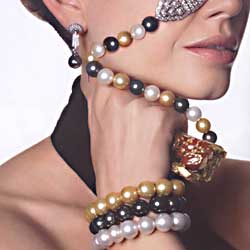Pearl: Beauty and Heritage
Pearl is Nature's Wondrous Creation

What is a pearl?
 Pearls are produced primarily by oysters and can take up to three years to produce. In response to an irritant in the oyster, layers and layers of nacre are coated around that irritant until eventually we end up with a lustrous pearl.
Pearls are produced primarily by oysters and can take up to three years to produce. In response to an irritant in the oyster, layers and layers of nacre are coated around that irritant until eventually we end up with a lustrous pearl.
Pearl History
In the late nineteenth century, pearl hunting was the primary way of obtaining pearls. This was a time-consuming and arduous task. Pearl divers would dive to river and floor beads and each oyster found had to be checked. Natural pearls were so rare that it would be lucky to find one pearl in 10,000 oysters found! To ease this situation, culturing pearls was formulated. That is why today, most pearls are manmade (or at least, man-helped) and are commonly referred to as cultured pearls.
Culturing pearls was first developed by Tatsuhei Mise Tokishi Nishikawa in Japan and this was later refined and perfected by Kokichi Mikimoto. Mikimoto was granted a patent for his process in 1916.
On average, an Akoya pearl takes a year to cultivate, and the Tahitian, and South Sea pearls take three years.
Types of Pearls
There are 2 main categories, based on where they are formed: freshwater pearls and saltwater pearls.
As their name implies, freshwater pearls are formed in freshwater mussels that live in freshwater ponds, rivers, and lakes.
Saltwater pearls are grown in oysters in the ocean.
The famous pearls like the Akoya, Tahitian, and South Sea pearls are all saltwater pearls.
Pearl Shapes
Pearls can come in a variety of shapes ~ from the classic round, to the oval, baroque, button (cushion-shaped), and the mabe (half sphere with one flat surface). Each of them are beautiful and distinctive in their own right.
Additional Pearl Information
The Largest Pearl
The largest pearl ~ the Pearl of Allah ~ was discovered in the Philippines in 1934 by a Muslim diver. It weighs a massive 6.4kg and came from a giant clam off the coast of Palawan Island. It is valued at approximately $40 million and was named by a Palawan tribal chief. This pearl was gifted by the Palawan chief to Wilbur Dowell Cobb in 1936 for saving the life of the chief's son.
Though originally named 'Pearl of Allah', it has now been officially renamed to 'Pearl of Lao Tzu'.
Most Famous Pearl
'Hope Pearl' is arguably the most famous natural salwater pearl ever discovered. It currently resides in the British Museum of Natural History. It weighs 450 carats, is a white, drop-shape blister pearl and measures 6 x 12 cm. Its lustrous sheen and colour ranges from greenish-gold to white.
Largest Natural Abalone pearl
The 'Big Pink Pearl' was valued in 1991 at USD$4.7 million. This baroque pearl weighs 470 carats.
Jewelry Care for your Pearls
Pearl strands should be strung properly - with a knot between each pearl. This prevents your pearls skittering across the floor and getting lost in the unfortunate even of the strand of pearls breaking. Traditionally, strands of pearls are always knotted between each pearl. Apart from loss in case the strand breaks, the in-between knot is also a good idea because pearls tend to continue excreting enzymes which can actually corrupt the threads. And pearl strand/necklace that is worn frequently should be restrung about once a year.
Pearls are softer than most other gemstones. So don't just throw your lovely pearls in amongst your other gems which will scratch the pearls. Also, the lustre of pearls are affected by heat which removes the natural moisture on the pearls surface. It is this natural moisture that gives your pearls its unmatchable lustre. Wrap your pearls up in soft, clean cloth, away from heat when storing.
To clean your pearls, wipe gently with damp (not wet) cloth. Water can cause pearls to discolour and the stringing thread to deteriorate. By the same reason, do not wear your pearls in baths, shower, spa, sauna, or when swimming. Dirty water and oils will also discolour pearls.
Return to JewelryMaking-Beads-Library Home
Back Up to Beads for Jewelry Making
Top of this Pearl knowledge

Like This Page?
New! Comments
Have your say! Leave a comment or suggestion in the box below.